Sodium Diacetate Manufacturer and Supplier
CAS No.: 126-96-5 | EC Number.: 204-814-9 | Molecular formula.: C4H7NaO4
Sodium Diacetate
Sodium Diacetate Manufacturers, Sodium Diacetate Suppliers, Sodium Diacetate Formula, Sodium Diacetate Price, Sodium Diacetate Exporter in Mumbai, India.
Vinipul Chemicals Pvt. Ltd. is a leading manufacturer, supplier, and exporter of high-purity Sodium Diacetate in India. C4H7NaO4 is known for its accurate composition and absence of impurities, achieved through the use of superior quality chemicals and state-of-the-art manufacturing equipment that comply with international industry standards.
At Vinipul Chemicals, we are committed to offering Sodium Diacetate (CAS Number 126-96-5) of the finest quality, with precisely the required composition and a long shelf life. Our product is a specialty chemical that can be used in a wide range of industrial applications, such as food preservation, pharmaceuticals, and the production of polymers.
As a customer-centric company, we prioritize the satisfaction of our clients by ensuring that our Sodium hydrogen diacetate is of the highest quality, at a competitive price. Our team of experts follows strict quality control measures during the manufacturing process to ensure that our customers receive a superior product that meets their requirements. if you are looking for a reliable source of high-purity Sodium Di Acetate with accurate composition and a long shelf life, Vinipul Chemicals is the perfect choice for you.
What is Sodium Diacetate?
Sodium diacetate is a chemical compound that has the molecular formula C4H7NaO4. This compound is a type of salt that is derived from acetic acid. It is a colourless solid that is commonly used as a seasoning and also as an antimicrobial agent in various applications. Sodium Di Acetate is a white, hygroscopic, crystalline solid with an odour of acetic acid. It is actually a mixture of sodium acetate and acetic acid. The molecular weight of 141.08 g/mol. When heated to decomposition, it emits acrid smoke and irritating fumes. Sodium diacetate is soluble in water and is also known as monosodium acetate.
Sodium Diacetate Details
This table provides information about Sodium Di Acetate, a chemical compound with the CAS No. 126-96-5 and EC Number 204-814-9. The table also lists various sodium diacetate common name and synonyms. The table contains molecular formula of Sodium Diacetate. It is a white powder that can be found in both dry powder and liquid forms. Sodium Diacetate pH. value is also mentioned in the table. Sodium Di Acetate is commonly used in the food industry as a preservative and flavour enhancer. It is also used in the pharmaceutical industry for various applications.
Specifications
| Chemical name | Sodium Di Acetate |
| CAS No | 126-96-5 |
| EC Number | 204-814-9 |
| Commercial name / Synonyms | Sodium Diacetate, Acetic acid, sodium salt (2:1), Sodium hydrogen diacetate, Dykon, Acid acetate, Sodium acid acetate, SDA, Sodium diacetate, SODIUM DIACETATE, SODIUM ACETATE BUFFER, Sodium diacetate acid, SODIUM DIACETATE HYDRATE, SODIUM HYDROGEN DIACETATE, SODIUM ACETATE ACETIC ACID, sodium hydrogen di(acetate), SODIUM ACETATE ACETIC ACID BUFFER, SODIUM HYDROGEN DIACETATE HYDRATE |
| Molecular formula | C4H7NaO4 |
| Chemical Structure |  |
| Melting Point | NA |
| IUPAC Name | NA |
| Parent Compound | Acetic Acid |
| Component Compounds | Acetic Acid Sodium |
| Physical Form | White powder |
| Physical Appearance | Dry Powder / Liquid |
| pH of 5% solution | 4.50 – 6.00 |
| Odour | Acetic acid (vinegar) odour |
| Solubility in water | 1 g/mL |
| Solubility in alcohol | Slightly |
| Solubility in ether | Insoluble |
| Packaging Details | 25 kg / 50 kg / HDPE packaging bags / Drum/ As per Client’s requirements |
Computed Properties
| Property Name | Property Value |
| Molecular Weight | 141.08 |
| Hydrogen Bond Acceptor Count | 4 |
| Exact Mass | 141.016378 |
| Monoisotopic Mass | 141.016378 |
| Heavy Atom Count | 9 |
| Formal Charge | -1 |
| Complexity | 25.5 |
| Covalently-Bonded Unit Count | 3 |
| Compound Is Canonicalized | Yes |
Related Compounds with Annotation
The table shows 50 different chemical compounds that are related to sodium diacetate, with their compound IDs, names, molecular formula, and molecular weight. The compounds include tetrasodium diacetate, disodium diacetate, sodium triacetate, calcium acetate sodium, and others. Many of these compounds contain additional elements such as magnesium, nickel, cobalt, lead, and zinc, which may affect their properties and potential applications.
| Structure | Compound CID | Name | Molecular Weight, g/mol | Molecular Formula |
|---|---|---|---|---|
 | 23662384 | Acetic acid, sodium salt (2:1) | 142.09 | C4H7NaO4 |
 | 15820984 | Sodium diacetate | 141.08 | C4H6NaO4- |
 | 18986384 | Tetrasodium;diacetate | 210.05 | C4H6Na4O4+2 |
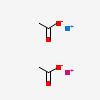 | 21470705 | Natriumacetat Kaliumacetat E | 180.18 | C4H6KNaO4 |
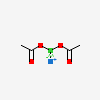 | 22086419 | CID 22086419 | 151.89 | C4H6BNaO4 |
 | 22287615 | Triacetic acid trisodium salt | 246. | C6H9Na3O6 |
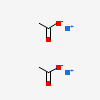 | 22646212 | Disodium;diacetate | 164.07 | C4H6Na2O4 |
 | 23207293 | Nickel(cento) acetate | 118.09 | C4H6O4-2 |
 | 92028388 | Sodium;triacetate | 200.12 | C6H9NaO6-2 |
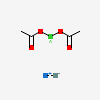 | 87103299 | Sodium;ethaneperoxoic acid;acetate | 158.08 | C4H7NaO5 |
 | 87352398 | CID 87352398 | 152.9 | C4H7BNaO4 |
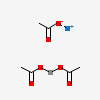 | 129637660 | Calcium acetate sodium | 240.2 | C6H9CaNaO6 |
 | 129634516 | Sodium acetate lead | 407 | C6H9NaO6Pb |
 | 129695848 | Disodium salt peracetic acid | 196.07 | C4H6Na2O6 |
 | 129641735 | Natriumacetat Barium | 337.45 | C6H9BaNaO6 |
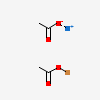 | 129679659 | Lithium;sodium;diacetate | 148 | C4H6LiNaO4 |
 | 129705065 | Sodium acetate-bromine | 220.98 | C4H6BrNaO4 |
 | 129714066 | Chlorine sodium acetate | 176.53 | C4H6ClNaO4 |
 | 12972103 | Sodium iodine acetate | 267.98 | C4H6INaO4 |
 | 139767826 | Sodium;acetyloxy ethaneperoxoate;acetate | 216.12 | C6H9NaO7 |
 | 140516998 | Magnesium;sodium;triacetate | 224.43 | C6H9MgNaO6 |
 | 14055659 | Disodium;diacetate;hydrochloride | 200.53 | C4H7ClNa2O4 |
 | 14104188 | Potassium;sodium;ethaneperoxoate | 212.17 | C4H6KNaO6 |
 | 157204264 | Magnesium;sodium;diacetate | 165.38 | C4H6MgNaO4+ |
 | 157427216 | Sodium;barium(2+);diacetate | 278.4 | C4H6BaNaO4+ |
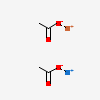 | 157529100 | Sodium;manganese(2+);triacetate | 255.06 | C6H9MnNaO6 |
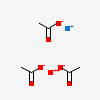 | 158196507 | Lithium;sodium;diacetate | 148 | C4H6LiNaO4 |
 | 157550835 | Magnesium;sodium;triacetate | 224.43 | C6H9MgNaO6 |
 | 157928273 | Sodium;strontium;triacetate | 287.74 | C6H9NaO6Sr |
 | 15829254 | Copper;sodium;diacetate | 204.62 | C4H6CuNaO4+ |
 | 158306878 | Sodium;nickel(2+);triacetate | 258.8 | C6H9NaNiO6 |
 | 158413766 | Cesium;sodium;diacetate | 273.98 | C4H6CsNaO4 |
 | 158569878 | Calcium;sodium;diacetate | 181.16 | C4H6CaNaO4+ |
 | 158739099 | CID 158739099 | 235.57 | C6H9ClNaO6 |
 | 158768656 | Trisodium;diacetate;chloride | 222.5 | C4H6ClNa3O4 |
 | 158804503 | Pentasodium;triacetate | 292.08 | C6H9Na5O6+2 |
 | 159118172 | Iodanium;sodium;diacetate | 270 | C4H8INaO4 |
 | 159184985 | Sodium;lead(2+);diacetate | 348 | C4H6NaO4Pb+ |
 | 159189616 | Sodium;cobalt(2+);triacetate | 259.05 | C6H9CoNaO6 |
 | 159294027 | Trisodium;diacetate | 187.06 | C4H6Na3O4+ |
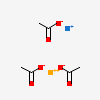 | 15934062 | Hydride;diacetate | 119. | C4H7O4-3 |
 | 159478970 | Sodium;iron(2+);triacetate | 255.97 | C6H9FeNaO6 |
 | 160359477 | Sodium;ZINC;triacetate | 265.5 | C6H9NaO6Zn |
 | 160736428 | Chloranium;sodium;diacetate | 178.55 | C4H8ClNaO4 |
 | 161095945 | Sodium;lead(2+);triacetate | 407 | C6H9NaO6Pb |
 | 161512906 | Sodium;nickel(2+);diacetate | 199.77 | C4H6NaNiO4+ |
 | 161682762 | Copper;sodium;triacetate | 263.67 | C6H9CuNaO6 |
 | 16183589 | Sodium;ZINC;diacetate | 206.5 | C4H6NaO4Zn+ |
 | 162116296 | Calcium;sodium;triacetate | 240.2 | C6H9CaNaO6 |
 | 16488839 | Sodium acetate strontium | 287.74 | C6H9NaO6Sr |
Sodium Diacetate Price
| Product Range | Price |
| Sodium Di acetate Powder | Rs 95/kilogram |
| Sodium Di acetate Crystal | Rs 95/kilogram |
| Sodium Di acetate – Food grade | Rs 95/kilogram |
Types of Sodium Diacetate

Sodium Di acetate Powder
Sodium Di acetate Powder is a type of salt made from acetic acid and sodium acetate. It is commonly used as a preservative and anti-staling agent in the food industry. The manufacturing process involves a reaction between acetic acid and sodium carbonate or between sodium acetate and ethanol, followed by high-pressure reaction and direct drying.

Sodium Di Acetate Crystal
Sodium Di acetate Crystal is a crystalline salt of acetic acid, which is manufactured through a one-step synthesis method. The raw materials used include glacial acetic acid, ionic membrane method caustic soda flakes, and anhydrous sodium carbonate. The process involves mixing the raw materials, heating, controlling the reaction temperature and time.

Sodium Di Acetate - Food Grade
Sodium Di acetate – Food grade is a food preservative and Flavouring Agent that is widely used in the food industry. It is a salt of acetic acid and is often added to baked goods, dairy products, meat, and seafood to prevent spoilage and extend their shelf life. Sodium Di acetate – Food grade is generally recognized as safe (GRAS).
Prices shown above are provisional prices and may change due to different market conditions for latest prices
Call Us
+91-932 223 1817
Mail Us
business@vinipulchemicals.com
How to Make Sodium Diacetate?
The manufacturing process of Sodium Di Acetate involves a reaction between acetic acid and sodium carbonate. The reactants used are acetic acid, acetic anhydride, and sodium carbonate, which are mixed in a high-pressure reactor. The reaction is controlled at a temperature of 40-50°C to ensure that the reactants react efficiently. Alternatively, sodium diacetate can also be directly produced by reacting sodium acetate and ethanol.
Once the reaction is complete, the mixture is allowed to cool down, and the resulting Sodium Diacetate is in a liquid form. The liquid is then dried directly, without concentration, resulting in high product yield, and saving power and working time.
The process of manufacturing Sodium Di Acetate requires precise control of temperature, pressure, and reactant concentration to ensure a high-quality product. Moreover, the equipment used in the manufacturing process must be of superior quality to ensure the efficiency and safety of the process.
Overall, the manufacturing process of sodium diacetate formula is a carefully controlled and complex process that requires expertise and experience. By using this process, manufacturers can produce high-quality Sodium Di Acetate that is suitable for a variety of applications, such as food preservation and pharmaceuticals.
What is the difference between acetate and diacetate?
Acetate and diacetate are both forms of the acetate ion, which is a negatively charged ion consisting of carbon, oxygen, and hydrogen atoms. The main difference between the two is that acetate has a single acetic acid molecule attached to the acetate ion, while diacetate has two acetic acid molecules attached to the acetate ion. This means that diacetate has a higher concentration of acetic acid than acetate and is therefore more acidic. Additionally, diacetate is often used as a food preservative and flavour enhancer, while acetate is used in a variety of applications, including as a solvent and in the production of textiles and plastics.
What is the difference between sodium acetate and sodium diacetate?
Sodium acetate and sodium diacetate are two different compounds with distinct chemical properties and uses. Sodium acetate is a salt of acetic acid and sodium, with a molar ratio of 1:1, and exists as a white crystalline powder. It is used in various applications, such as in the food industry as a flavouring agent, and in medicine as a diuretic.
On the other hand, sodium diacetate is a compound formed by the reaction of acetic acid with sodium bicarbonate or sodium carbonate, and has a molar ratio of 1:1 between acetic acid and sodium acetate. It is commonly used in the food industry as a preservative, as well as a flavouring agent and mold inhibitor. Sodium diacetate is also used in the pharmaceutical and cosmetic industries as a pH regulator and buffering agent.
Is sodium diacetate organic or inorganic?
Sodium diacetate is an inorganic compound. It is a sodium salt of acetic acid, which is a synthetic organic acid. While sodium diacetate is derived from acetic acid, it is not considered to be an organic compound because it contains a metal ion (sodium) that is not bonded to a carbon atom. Organic compounds are defined as compounds that contain carbon atoms that are covalently bonded to other atoms, typically including hydrogen, oxygen, and nitrogen. Since sodium diacetate does not meet this definition, it is classified as an inorganic compound.
What foods contain sodium diacetate?
Sodium diacetate in food is commonly used as a preservative and flavouring agent in a variety of products. Some foods that may contain sodium diacetate include baked goods, snack foods, fats and oils, meat products, candy, gravies and sauces, soups and soup mixes. It is often added to foods to prevent spoilage and inhibit the growth of bacteria, as well as to provide a tangy or sour taste. The specific foods that contain sodium diacetate will depend on the manufacturer and the recipe used.
What is Sodium Diacetate used for in food?
Sodium diacetate is commonly used as a preservative for stored grains to prevent spoilage by controlling the growth of molds and bacteria. It is a registered fungicide and bactericide, meaning that it has been approved for use in agricultural settings to protect stored grains from microbial contamination. By inhibiting the growth of molds and bacteria, sodium diacetate can help to extend the shelf life of grains and prevent spoilage, which can lead to significant economic losses for farmers and food processors. Additionally, the use of sodium diacetate as a preservative in stored grains can help to ensure that these products remain safe for human consumption by preventing the growth of harmful bacteria and mycotoxins that can be produced by certain types of molds.
Industrial Applications
Sodium diacetate has various applications in different industries as follows:

Pharmaceutical Sector
Sodium diacetate is used in the pharmaceutical industry as a preservative to extend the shelf life of medications. It is also used as a pH regulator to maintain the acidity of the solution at the desired level. Additionally, sodium diacetate is used as a buffering agent to stabilize the pH

Chemical Industries
Sodium diacetate is used as an intermediate in the production of various chemicals such as dyes, pigments, and pharmaceuticals. It is also used as a pH regulator in the production of other chemicals and helps in maintaining the desired pH levels for optimal chemical reactions.

Food Industry
Sodium diacetate is widely used as a preservative in the food industry. It helps to inhibit the growth of bacteria and fungi that can spoil food, thus extending its shelf life. Additionally, sodium diacetate is used as a flavouring agent to enhance the taste of food products such as.

Drugs
Sodium diacetate is used in the production of various drugs and pharmaceutical products. It is used as a preservative to prevent the growth of microorganisms in liquid formulations and maintain their potency. Sodium diacetate is also used as a buffering agent to maintain the pH levels

Textile Industries
Sodium diacetate is used in the textile industry as a pH regulator in the dyeing and printing of fabrics. It helps to maintain the desired pH level, which is essential for the fixation of dyes on the fabric.

Fertilizer Sector
Sodium diacetate is used as a buffering agent and pH regulator in the production of fertilizers. It helps to stabilize the pH of the soil and improve the effectiveness of the fertilizers.

Leather and Tanning Industry
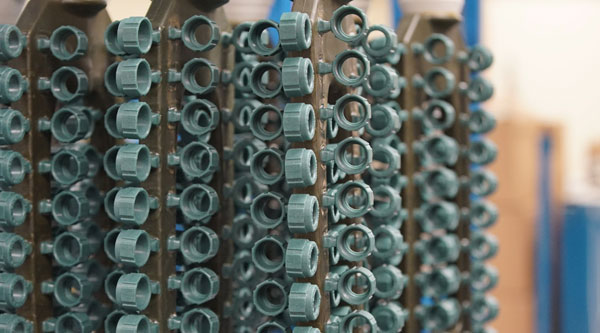
Die and Precision Casting
Sodium diacetate is used in the die and precision casting industry as a mold inhibitor and preservative. It helps to prevent the growth of bacteria and fungi that can cause damage to the molds and castings.

Food Processing Industry
Sodium diacetate is used in the food processing industry as a preservative to extend the shelf life of food products. It is also used as a pH regulator in various food products to ensure their safety and quality.

Agriculture Industry
Sodium diacetate is used as a buffering agent and pH regulator in the production of agricultural products such as pesticides and herbicides. It helps to stabilize the pH of the soil and improve the effectiveness of the products.

Rubber Industry

Colouring Industries

Inorganic Chemical Sector

Glass industry

Paint Industry

Heat Process Equipment Industry
In summary, sodium diacetate is a versatile compound with numerous applications in various industries. It is used as a preservative, pH regulator, buffering agent, and mold inhibitor, among other uses. Its wide range of applications makes it an important compound in the production of many products, from food and pharmaceuticals to industrial equipment and chemicals.
Sodium Diacetate Uses
Sodium diacetate has several uses including:
- Sodium diacetate is used as a preservative for poultry and red meat products, as it inhibits the development of certain bacterial strains.
- It is also used to control acidity in fresh meat and as a sour agent and pH regulator in food products.
- Sodium diacetate is utilized to control pH in the photographic and foam production industries.
- In personal care products, it is used as a masking ingredient, a fragrance, and a buffering agent.
- The pharmaceutical industry uses sodium diacetate for renal dialysis.
- It is registered as a fungicide and bactericide for controlling molds and bacteria in stored grains to prevent spoilage.
- Solid forms of sodium diacetate are used as inhibitors of molds and rope-forming bacteria in bread.
- Sodium diacetate finds applications as a buffering agent, in mordants, varnish hardeners, souring agent, intermediate for acid salts, and anti-tarnishing agents.
- Sodium diacetate powder is a colourless solid that is used in seasonings and as an antimicrobial agent.
- In the food industry, sodium diacetate is used as food additives such as Acidulants and pH adjusters, metal sequestering agents, antifungal agents, and viscosifying agents.
In addition, it is used in solid dialysis preparations for patients with renal failure, controlled to prevent the volatilization of acetic acid as a pH adjusting agent.
Can you buy sodium diacetate?
If you are looking to buy sodium diacetate look no further than Vinipul Chemicals Pvt. Ltd., a leading manufacturer, supplier, and exporter of high-quality sodium diacetate. We are committed to offering our customers the best possible prices and we understand that price is an important factor in any purchasing decision, and we work hard to keep our prices competitive without compromising on quality. Our team is always available to provide customized pricing options based on the specific needs of our customers. We also offer a range of convenient payment options to make the purchasing process as easy as possible. At Vinipul Chemicals, we take pride in our commitment to providing exceptional products and services at affordable prices, and we are confident that you will be satisfied with your purchase. Please feel free to reach out to us if you have any inquiries or if you would like to place an order.
FAQ's
Sodium diacetate chemical formula: – (NaC2H3O2)x + (C2H4O2)y
As a food flavouring additive, it has E number E262 and is used to impart a salt and vinegar flavour.
Sodium diacetate is considered safe to eat by regulatory agencies when used in accordance with approved uses and levels. It is approved for use as a food additive in many countries, including the United States and European Union.
Sodium diacetate is not a natural compound as it is synthetically produced by the reaction of acetic acid with sodium bicarbonate or sodium carbonate.
Diacetate refers to a chemical compound that contains two acetyl groups (CH3COO-) in its molecular structure. Sodium diacetate, for example, is a compound that contains two acetyl groups and a sodium ion.
Yes, sodium diacetate is classified as a food additive and is commonly used in the food industry as a preservative, flavour enhancer, acid regulator, and antimicrobial agent.
Sodium diacetate is a synthetically produced compound, which means it is not found naturally in food sources. However, it is approved for use as a food additive by regulatory agencies and is considered safe for human consumption.
Yes, sodium diacetate is a type of salt. It is composed of a sodium cation (Na+) and a diacetate anion (CH3COO-)2.
The pH of a 1% solution of sodium diacetate is approximately 4.5-5.0. Sodium diacetate is commonly used as an acid regulator and pH stabilizer in food products.
The MOQ for Purchasing Sodium Diacetate is 25 kg / 50 kg.
The material used for Sodium Diacetate is HDPE packaging bags or Drum.
Market Area
We supply and exports Sodium Di Acetate in all parts of the world such as
Sodium Di Acetate in Africa Countries
South Africa , Nigeria, Kenya, Ghana, Ethiopia, Tanzania, Algeria, Angola, Benin, Botswana, Burkina Faso, Burundi, Cabo Verde, Cameroon, Central African Republic (CAR), Chad, Comoros, Democratic Republic of the Congo, Cote d’Ivoire, Djibouti, Egypt, Equatorial Guinea, Eritrea, Gabon, Gambia, Guinea, Guinea-Bissau, Lesotho, Liberia, Libya, Madagascar, Malawi, Mali, Mauritania, Mauritius, Morocco, Mozambique, Namibia, Nigeria, Rwanda, Sao Tome and Principe, Senegal, Seychelles, Sierra Leone, Somalia, South Sudan, Sudan, Swaziland, Togo, Tunisia, Uganda, Zambia, Zimbabwe.
Sodium Di Acetate in Gulf Countries
Oman, Qatar, Kuwait, Saudi Arabia, Dubai, Bahrain, Iran, United Arab Emirates
Sodium Di Acetate in Asia Countries
Afghanistan, Armenia, Azerbaijan, Bahrain, Bangladesh, Bhutan, Brunei, Cambodia, China, Cyprus, Georgia, India, Indonesia, Iran, Iraq, Israel, Japan, Jordan, Kazakhstan, Kuwait, Kyrgyzstan, Laos, Lebanon, Malaysia, Maldives, Mongolia, Myanmar (Burma), Nepal, North Korea, Oman, Pakistan, Palestine, Philippines, Qatar, Russia, Saudi Arabia, Singapore, South Korea, Sri Lanka, Syria, Taiwan, Tajikistan, Thailand, Timor-Leste, Turkey, Turkmenistan, United Arab Emirates (UAE), Uzbekistan, Vietnam, Yemen
We supply Sodium Di Acetate in all parts of India.
Andhra Pradesh, Arunachal Pradesh, Assam, Bihar, Chhattisgarh, Goa, Gujarat, Haryana, Himachal Pradesh, Jammu & Kashmir, Jharkhand, Karnataka, Kerala, Madhya Pradesh, Maharashtra, Manipur, Meghalaya, Mizoram, Nagaland, Odisha, Punjab, Rajasthan, Sikkim, Tamil Nadu, Telangana, Tripura, Uttarakhand, Uttar Pradesh and West Bengal.
Note: – Please be advised that the information contained in this document is intended for illustrative purposes only. Due to variations in product grade, applications, industries, or uses, the accuracy of the information provided cannot be guaranteed. © Copyright 2023 © Vinipul Chemicals All Rights Reserved (Terms of Use). Reproduction of any material from this site is strictly prohibited without permission. Vinipul Chemicals products are exclusively sold through the company’s website. For precise product specifications and requirements, as well as advice on which products are best suited for your specific application needs, please contact us at business@vinipulchemicals.com Use Terms | Privacy.


